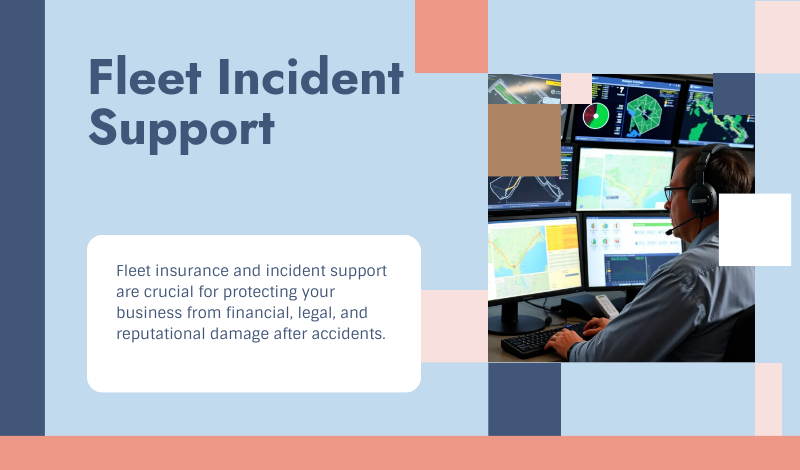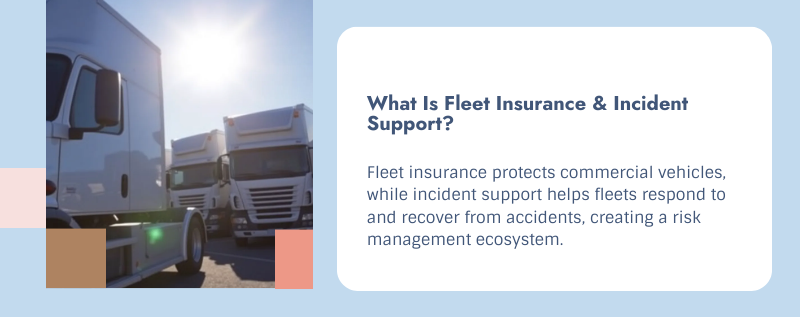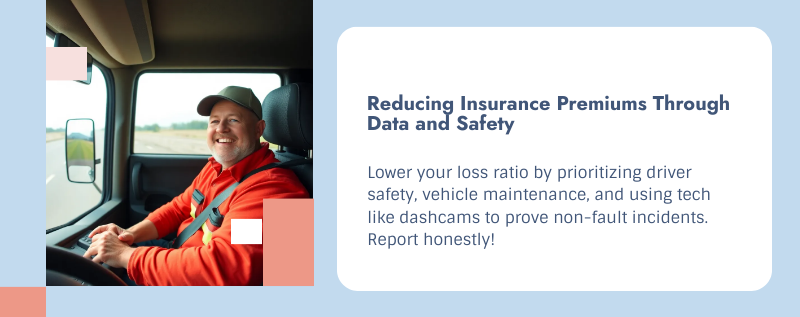Why Fleet Insurance and Incident Support Matter
For fleets, accidents aren’t just safety events — they’re financial, legal, and reputational turning points. One poorly handled incident can cost thousands in repairs, insurance premiums, and downtime.
A strong insurance and incident support program ensures your business stays operational, compliant, and financially protected. It gives you the structure to respond immediately, manage claims efficiently, and prevent repeat events.
Let’s explore:
-
The core components of a fleet insurance strategy
-
How to create a structured incident response plan
-
Best practices for managing claims and documentation
-
Ways to reduce costs and improve risk profiles
-
FAQs that answer the most common fleet insurance questions
What Is Fleet Insurance & Incident Support?
Fleet insurance covers a group of commercial vehicles under a single policy, offering financial protection from accidents, damage, and liability claims.
Incident support refers to the systems and procedures that help a fleet respond to, document, and recover from any event — from minor fender benders to major collisions.
Together, they form a risk management ecosystem that protects your business against unexpected losses while keeping vehicles and drivers safe.
Core Components of an Effective Fleet Insurance Program
A well-structured fleet insurance plan should include these key coverages:
1. Commercial Auto Liability
Protects against bodily injury and property damage caused by your drivers. Required by law in most states.
2. Physical Damage Coverage
Includes both collision and comprehensive protection for your vehicles — from crashes to weather or theft.
3. Uninsured / Underinsured Motorist
Covers you when another driver causes damage but lacks sufficient insurance.
4. Cargo and Equipment Coverage
Essential for trucking and logistics fleets. Protects the goods you transport and onboard tools or specialized gear.
5. General Liability
Covers non-auto incidents related to your business (such as on-site injuries or property damage).
6. Workers’ Compensation
Supports employees injured on the job, whether driving, loading, or working in the yard.
By aligning all of these coverages, you build a safety net that ensures incidents don’t escalate into operational crises.
The Fleet Incident Response Plan (IRP)
A Fleet Incident Response Plan defines exactly how your team should act after an accident. It minimizes confusion, preserves evidence, and ensures your claims are handled properly.
Step 1: Ensure Safety First
-
Move vehicles to a safe area, if possible.
-
Turn on hazard lights and set up cones or flares.
-
Check for injuries and call emergency services immediately.
Step 2: Document Everything
-
Record the date, time, and location.
-
Take wide and close-up photos of all vehicles and surroundings.
-
Note road conditions, weather, and signage.
-
Collect driver’s licenses, insurance details, and witness information.
Step 3: Notify Dispatch and Management
Drivers should contact their dispatcher or safety manager as soon as possible. Quick notification ensures compliance with insurance reporting timelines.
Step 4: Report to Your Insurance Provider
Submit an initial incident report within 24 hours. Include all collected evidence and keep copies of repair estimates or medical documentation.
Step 5: Review, Repair, and Analyze
-
Schedule vehicle repairs with approved vendors.
-
Record costs and downtime.
-
Conduct a post-incident review to identify causes and prevention opportunities.
How to Handle Fleet Claims Efficiently
A delayed or incomplete claim can result in higher costs and lost coverage. Streamline your process by following these best practices:
1. Assign an Incident Coordinator
Have one person or small team responsible for triaging all accidents, liaising with insurers, and tracking claim progress.
2. Use Telematics for Real-Time Alerts
Modern telematics systems automatically detect collisions and send alerts with GPS location, speed, and video footage. This data improves claim accuracy and speeds resolution.
3. Centralize Your Documentation
Store all photos, repair invoices, medical records, and claim communications in one digital repository. This simplifies audits and legal reviews.
4. Track Key Claim Metrics
Monitor:
-
Average claim cost
-
Frequency of incidents
-
Downtime per claim
-
Recovery rates (subrogation)
-
Resolution time
Consistent analysis helps you identify patterns and reduce risk exposure.
Reducing Insurance Premiums Through Data and Safety
Insurance costs are heavily influenced by your loss ratio — the balance between what your insurer pays out in claims and what you pay in premiums.
To keep premiums low:
-
Maintain a driver safety program with regular training and performance monitoring.
-
Enforce pre-trip inspections and preventive maintenance to reduce mechanical failure claims.
-
Use dashcams and telematics to prove non-fault incidents and prevent fraudulent claims.
-
Encourage a reporting culture — early, honest reporting improves claim defensibility.
-
Track incident causes and apply corrective measures company-wide.
Fleets that demonstrate proactive risk control often receive insurance discounts or policy incentives.
Integrating Maintenance, Safety, and Insurance Data
A best-in-class fleet doesn’t treat maintenance, safety, and insurance as separate silos. Integration is key.
By linking your maintenance management system with incident and claims data, you can see patterns:
-
Brake-related claims may trace back to deferred maintenance.
-
Tire blowouts could correlate with specific routes or driver habits.
-
Equipment damage might cluster around particular loading facilities.
When all departments share visibility, your fleet becomes more efficient, safer, and insurable at better rates.
Post-Incident Recovery: Lessons and Continuous Improvement
After every claim, hold a post-incident review to examine:
-
What caused the incident (driver, mechanical, environmental)?
-
How effectively was it reported?
-
Were response times adequate?
-
Did the documentation meet insurer requirements?
-
What policy or training changes can prevent recurrence?
Turning each claim into a learning event builds institutional resilience — the hallmark of mature fleet operations.
Advanced Tactics & Technology Trends in Incident Support
To move beyond “paper-based incident recovery” and achieve market-leading resilience, modern fleets are embracing new approaches and technologies that reshape how claims, liabilities, and costs are managed.
Video Telematics & Context-Aware Evidence
Video telematics systems combine live or event-triggered video capture with GPS, accelerometer, braking, and speed data. When a collision or sudden maneuver occurs, these systems automatically store synchronized video and sensor logs.
The advantages are clear:
-
Objective context: Footage captures angles, driver reaction, road conditions, and third-party vehicles, giving your claims team higher-confidence evidence.
-
Faster claim resolution: Insurers often settle faster when robust data accompanies a claim, reducing dispute cycles.
-
Deterrence & coaching: Knowing video is available influences driver behavior. Post-incident review with video strengthens coaching impact.
-
Fraud protection: Video helps filter out dubious or exaggerated claims by third parties.
Because video telematics is becoming widespread and expected, incorporating it into your incident support system elevates your defensibility and shifts you from claimant to data-led responder.
Driver Behavior Scoring & Risk Profiling
Driver scoring algorithms analyze telematics data (hard braking, cornering, speed variance, idling) and assign risk scores. Over time:
-
High-risk drivers (per score) can be put through targeted training or restricted routes.
-
Incident support teams use the score history to inform liability assessments.
-
Insurers may reward high-scoring fleets with premium discounts.
This “proactive risk control” approach shifts your posture from reactive to predictive. Insurers see you as managing risk, not just absorbing it.
Integrated Incident + Maintenance + Claims Platforms
In high-performing fleets, incident workflows don’t live in isolation. They are integrated with:
-
Maintenance systems: So collisions suspected to be mechanical failures automatically flag maintenance review.
-
Routing / dispatch systems: Incident-blocked vehicles trigger rerouting without manual handoffs.
-
Claims management platforms: Centralized dashboards track all stages — reporting, adjuster, repair shop, subrogation, closure.
-
Analytics & Business Intelligence layers: Trend detection (e.g. high incident clusters by corridor or by driver) drives preventive changes.
This “single pane of truth” architecture ensures no data gets siloed, reducing friction between operations, safety, and risk teams.
Risk Management & Insurance Strategy Alignment
Incident support doesn’t stand alone — it’s part of the broader fleet risk management posture. To make it strategic, tie it into your insurance and underwriting approach.
Loss Ratio & Underwriting Negotiation
Your incident record (frequency, severity, resolution speed) feeds directly into the loss ratio tool insurers use. Lower, more predictable losses help you:
-
Negotiate lower premium increases
-
Secure better deductibles or retention structures
-
Qualify for safety credits, program discounts, or loss control incentives
Tracking your incident metrics and presenting them during renewals can unlock financial value.
Tiered Coverage & Risk Segmentation
Not all assets or routes carry equal risk. Use incident data to segment:
-
High-risk routes or geographies
-
High-utilization, heavy-duty vehicles
-
Drivers with prior incidents
For each segment, you can layer different coverage, deductibles, or safety mandates — optimizing cost vs protection rather than uniform policy across your entire fleet.
Subrogation & Recovery Discipline
Maximizing subrogation is a hidden margin lever. Good subrogation practice involves:
-
Early liability determination
-
Capturing forensic evidence (video, telematics, witness)
-
Engaging subrogation counsel when needed
-
Tracking recovery rates and holding underperforming claims accountable
Because subrogation recovers costs you’ve paid, it effectively lowers your net loss exposure over time.
Operational Best Practices to Strengthen Incident Support
Those that excel don’t just have tools — they embed process discipline and cross-functional alignment. Below are “best practices” that differentiate top-tier fleets.
Rapid Triage & Incident Classification
Don’t treat every incident the same. Quickly triage by severity (e.g. Tier 1–Tier 4) and assign escalation paths accordingly. This ensures minor events don’t consume undue resources and major ones get the urgent attention they require.
Evidence Chain-of-Custody Protocols
Maintaining a defensible chain-of-custody is essential. Steps include:
-
Timestamped photo capture
-
Locking video and telematics logs immediately
-
Sealing physical evidence (e.g. damaged parts)
-
Using standardized forms and digital controls
In legal or insurer review, weak chain-of-custody is often a point of challenge.
External Partnerships & Preferred Networks
Don’t rely on ad hoc vendors. Maintain a preferred network of:
-
Repair shops with guaranteed SLAs
-
Towing and salvage vendors with access agreements
-
Independent adjusters or incident consultants
-
Legal and subrogation partners experienced in transportation claims
A vetted network reduces surprises, speeds repair, and ensures consistent standards.
Post-Claim Root Cause Drills & Corrective Action
After an incident closes, conduct a structured review:
-
What caused it (driver, route, equipment)?
-
What policies or oversight failed?
-
What training or operational change will prevent recurrence?
-
Which drivers or routes are trending above norms?
Feed these findings into safety, dispatch, and maintenance loops — closing the loop between incident support and operational improvement.
Reporting & Transparency to Stakeholders
Use dashboards and regular reporting to share:
-
Incident frequency / per 100,000 miles
-
Average cost per claim
-
Recovery / subrogation rate
-
Downtime lost
-
Top risk corridors or vehicles
These metrics help leadership understand risk, guide capital allocation, and influence insurance strategy.
FAQ: Fleet Insurance & Incident Support
Q1: What does fleet insurance typically cover?
Fleet insurance usually includes liability, collision, comprehensive, uninsured motorist, and cargo protection. It can be customized to cover trailers, equipment, and even driver medical expenses.
Q2: How do I report a fleet accident to insurance?
Collect all incident details (photos, witness info, police report) and notify your insurer within 24 hours. Use your company’s incident report form to standardize submissions.
Q3: How can I lower fleet insurance premiums?
Reduce claims by investing in telematics, driver safety programs, and preventive maintenance. Maintain clean driving records and show insurers a detailed risk reduction strategy.
Q4: What should drivers do immediately after an accident?
Prioritize safety, contact emergency services, document the scene, collect information, and notify dispatch. Never admit fault or make on-the-record statements at the scene.
Q5: Why is documentation so critical in incident support?
Complete, time-stamped documentation ensures accurate claims and legal protection. Missing photos or inconsistent statements can invalidate insurance coverage or increase settlement costs.
Q6: What’s the difference between insurance claims and incident reporting?
An incident report captures operational details for internal records, while an insurance claim formally requests coverage or reimbursement for damages or injuries.
Q7: How long should fleets keep incident and claim records?
Keep records for at least 5–7 years, depending on your state’s liability laws and insurance requirements.
Q8: Can telematics data be used in accident investigations?
Yes. GPS and video evidence provide objective proof of vehicle speed, location, and driver behavior, strengthening your position during claim disputes or litigation.
Q9: How do post-incident reviews help improve fleet safety?
They identify patterns — like repeat driver behaviors, unsafe routes, or mechanical weak points — enabling corrective training and equipment updates.
Q10: What tools can help manage fleet insurance and incident reporting?
Use fleet management platforms that combine maintenance, telematics, and claims tracking. This integration automates documentation, improves accuracy, and simplifies communication with insurers.
Final Thoughts: Turning Incident Management Into Competitive Advantage
Fleet insurance and incident support aren’t reactive functions — they’re strategic. When your organization responds quickly, documents thoroughly, and learns from every event, you reduce costs and build trust with insurers and clients alike.
By combining robust insurance coverage, telematics technology, and a disciplined response plan, your fleet can protect its people, preserve assets, and maintain operational continuity — even when the unexpected happens.





